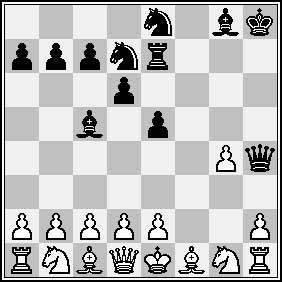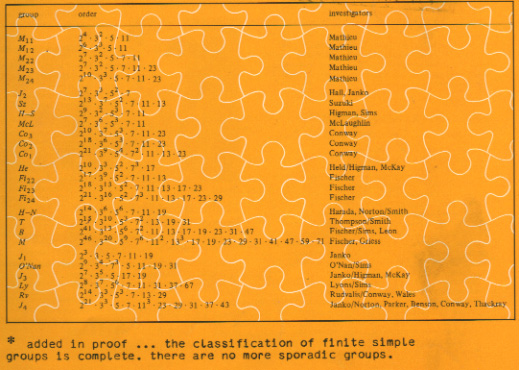 Noam D. Elkies is a
Noam D. Elkies is a
Harvard mathematician whose main research interests have to do with
lattices and elliptic curves. He is also a very talented composer of
chess problems. The problem to teh left is a proof game
in 14 moves. That is, find the UNIQUE legal chess game leading to the
given situation after the 14th move by black. Elkies has also written a
beautiful paper On Numbers
and Endgames applying combinatorial game theory (a la Winning
Ways!) to chess-endgames (mutual Zugzwang positions correspond to zero
positions) and a follow-up article Higher Nimbers in pawn
endgames on large chessboards. Together with Richard Stanley he wrote a
paper for the Mathematical Intelligencer called The Mathematical
Knight which is stuffed with chess problems! But perhaps most
surprising is that he managed to run his own course on Chess and
Mathematics!
Category: featured

This morning,
Michel Van den Bergh posted an interesting paper on the arXiv
entitled Double
Poisson Algebras. His main motivation was the construction of a
natural Poisson structure on quotient varieties of representations of
deformed multiplicative preprojective algebras (introduced by
Crawley-Boevey and Shaw in Multiplicative
preprojective algebras, middle convolution and the Deligne-Simpson
problem) which he achieves by extending his double Poisson structure
on the path algebra of the quiver to the 'obvious' universal
localization, that is the one by inverting all $1+aa^{\star} $ for $a $ an
arrow and $a^{\star} $ its double (the one in the other direction).
For me the more interesting fact of this paper is that his double
bracket on the path algebra of a double quiver gives finer information
than the _necklace Lie algebra_ as defined in my (old) paper with Raf
Bocklandt Necklace
Lie algebras and noncommutative symplectic geometry. I will
certainly come back to this later when I have more energy but just to
wet your appetite let me point out that Michel calls a _double bracket_
on an algebra $A $ a bilinear map
$\{ \{ -,- \} \}~:~A \times A
\rightarrow A \otimes A $
which is a derivation in the _second_
argument (for the outer bimodulke structure on $A $) and satisfies
$\{ \{ a,b \} \} = – \{ \{ b,a \} \}^o $ with $~(u \otimes v)^0 = v
\otimes u $
Given such a double bracket one can define an ordinary
bracket (using standard Hopf-algebra notation)
$\{ a,b \} = \sum
\{ \{ a,b \} \}_{(1)} \{ \{ a,b \} \}_{(2)} $
which makes $A $ into
a Loday
algebra and induces a Lie algebra structure on $A/[A,A] $. He then
goes on to define such a double bracket on the path algebra of a double
quiver in such a way that the associated Lie structure above is the
necklace Lie algebra.

I
found an old copy (Vol 2 Number 4 1980) of the The Mathematical Intelligencer with on its front
cover the list of the 26 _known_ sporadic groups together with a
starred added in proof saying
- added in
proof … the classification of finite simple groups is complete.
there are no other sporadic groups.
(click on the left picture to see a larger scanned image). In it is a
beautiful paper by John Conway “Monsters and moonshine” on the
classification project. Along the way he describes the simplest
non-trivial simple group $A_5 $ as the icosahedral group. as well as
other interpretations as Lie groups over finite fields. He also gives a
nice introduction to representation theory and the properties of the
character table allowing to reconstruct $A_5 $ only knowing that there
must be a simple group of order 60.
A more technical account
of the classification project (sketching the main steps in precise
formulations) can be found online in the paper by Ron Solomon On finite simple
groups and their classification. In addition to the posts by John Baez mentioned
in this
post he has a few more columns on Platonic solids and their relation to Lie
algebras, continued here.